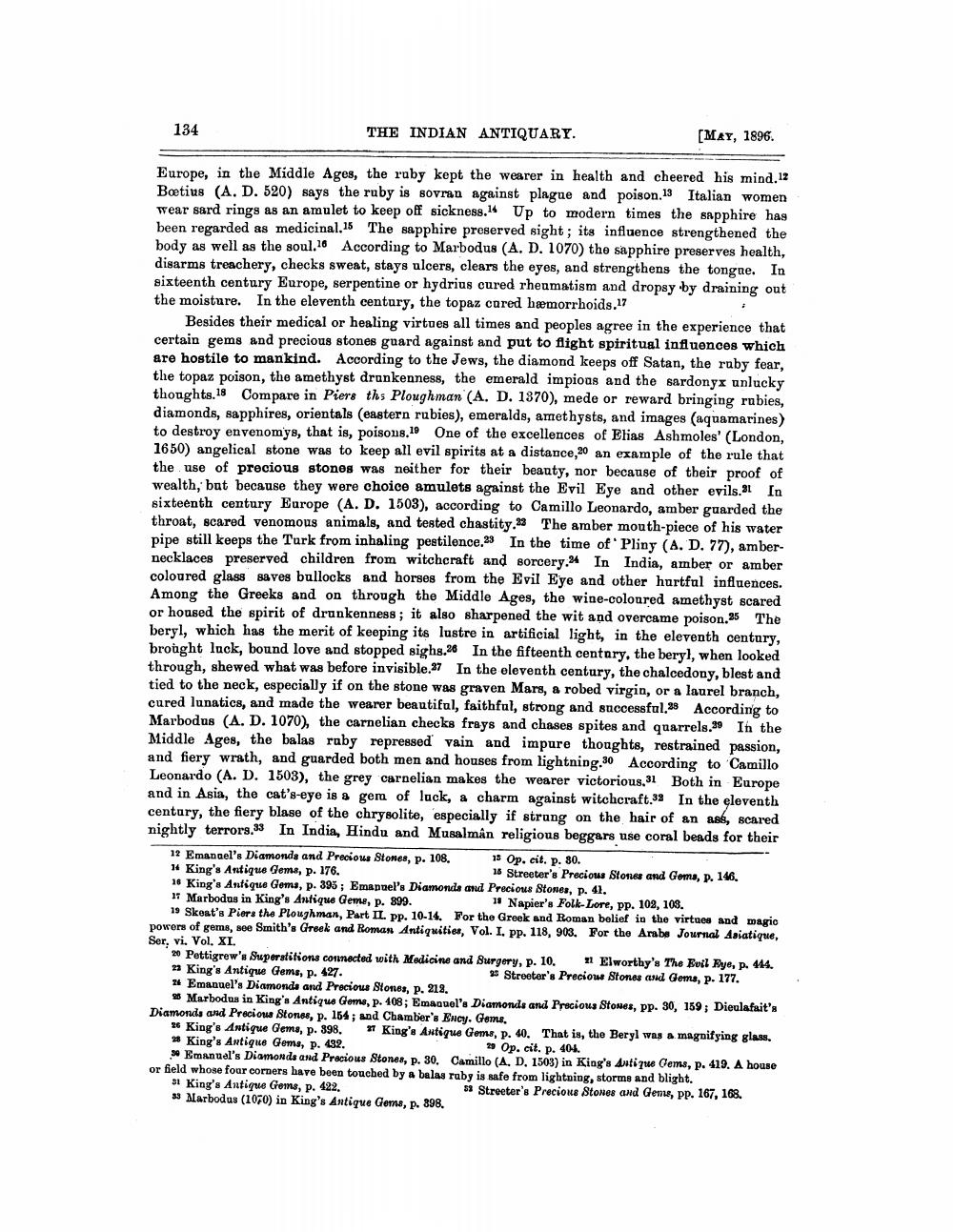________________
134
THE INDIAN ANTIQUARY.
[MAY, 1896.
Europe, in the Middle Ages, the ruby kept the wearer in health and cheered his mind.12 Boetius (A. D. 520) says the ruby is sovran against plague and poison.13 Italian women wear sard rings as an amulet to keep off sickness. Up to modern times the sapphire has been regarded as medicinal.15 The sapphire preserved sight; its influence strengthened the body as well as the soul.16 According to Marbodus (A. D. 1070) the sapphire preserves health, disarms treachery, checks sweat, stays ulcers, clears the eyes, and strengthens the tongue. In sixteenth century Europe, serpentine or hydrius cured rheumatism and dropsy by draining out the moisture. In the eleventh century, the topaz cared hæmorrhoids.?
Besides their medical or healing virtues all times and peoples agree in the experience that certain gems and precious stones guard against and put to flight spiritual influences which are hostile to mankind. According to the Jews, the diamond keeps off Satan, the ruby fear, the topaz poison, the amethyst drankenness, the emerald impious and the sardonyx unlucky thoughts 18 Compare in Piers ths Ploughman (A. D. 1870), mede or reward bringing rubies, diamonds, sapphires, orientals (eastern rubies), emeralds, amethysts, and images (aquamarines) to destroy envenomys, that is, poisons.19 One of the excellences of Elias Ashmoles' (London, 1650) angelical stone was to keep all evil spirits at a distance,20 an example of the rule that the use of precious stones was neither for their beauty, nor because of their proof of wealth, but because they were choice amulets against the Evil Eye and other evils. In sixteenth century Europe (A. D. 1503), according to Camillo Leonardo, amber guarded the throat, scared venomous animals, and tested chastity. The amber mouth-piece of his water pipe still keeps the Turk from inhaling pestilence.28 In the time of Pliny (A. D. 77), ambernecklaces preserved children from witchcraft and sorcery.24 In India, amber or amber coloured glass saves bullocks and horses from the Evil Eye and other hurtful influences. Among the Greeks and on through the Middle Ages, the wine-coloured amethyst scared or housed the spirit of drunkenness; it also sharpened the wit and overcame poison.35 The beryl, which has the merit of keeping its lustre in artificial light, in the eleventh century, bronght luck, bound love and stopped sighs.26 In the fifteenth century, the beryl, when looked through, shewed what was before invisible 37 In the eleventh century, the chalcedony, blest and tied to the neck, especially if on the stone was graven Mars, a robed virgin, or a laurel branch, cured lunatics, and made the wearer beautiful, faithful, strong and successful,33 According to Marbodus (A. D. 1070), the carnelian checks frays and chases spites and quarrels.39 In the Middle Ages, the balas ruby repressed vain and impure thoughts, restrained passion, and fiery wrath, and guarded both men and houses from lightning.30 According to Camillo Leonardo (A. D. 1503), the grey carnelian makes the wearer victorious,31 Both in Europe and in Asia, the cat's-eye is a gem of luck, a charm against witchcraft.32 In the eleventh century, the fiery blase of the chrysolite, especially if strong on the hair of an ass, scared nightly terrors.33 In India, Hindu and Musalman religious beggars use coral beads for their
12 Emanuel's Diamonds and Precious Stones, p. 108. 13 Op. cit. p. 80. 14 King's Antique Geme, p. 176.
16 Streeter's Precious stones and Goms, p. 146. 16 King's Antique Goms, p. 395; Emappel's Diamonds and Precious Stones, p. 41. 11 Marbodus in King's Antique Geme, p. 899.
1 Napier's Folk-Lore, pp. 102, 108. 19 Skont's Piers the Ploughman, Part IL. Pp. 10-14. For the Greek and Roman belief in the virtues and magio powers of gems, see Smith's Greek and Roman Antiquities, Vol. I. pp. 118, 903. For the Arabe Journal Asiatique, Ser, vi. Vol. XL. 20 Pettigrew's Superstitions connected with Medicine and Surgery, p. 10. 11 Elworthy's The Evil Eye, p. 44. King's Antique Gems, p. 427.
23 Streeter's Preciow Stones and Gems, P. 177. 24 Emanuel's Diamonds and Preciowe Stones, p. 218.
Marbodus in King's Antique Gome, p. 108; Emanuel's Diamonule and Precious Stones, pp. 30, 159; Dieulafait's Diamonds and Preciowe Stones, p. 164; and Chamber's Ency. Geme.
* King's Antique Gems, p. 398. 91 King's Antique Gems, p. 40. That is, the Beryl was a magnifying glass. » King's Antique Gems, p. 432.
2 Op. cit. p. 40%. Emanuel's Diamonds and Precious Stones, p. 30. Camillo (A, D, 1503) in King's Antique Cems, p. 419. A house or field whose four corners have been touched by a balas raby is safe from lightning, storms and blight. 31 King's Antique Goms, p. 422.
53 Streeter's Precious stones and Gens, pp. 167, 168. » Marbodas (1070) in King's Antique Gems, p. 398.




